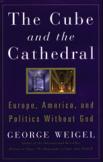The Democratic Project
The newest book by the papal biographer and social commentator George Weigel owes much of its theory to the late Pope John Paul II, and its main questions read like a sermon by the new pope, Benedict XVI. The Cube and the Cathedral is an excellent read. It is clear, to the point and engaging, and encourages the reader to ponder questions that otherwise might be left to the Op Ed page of The New York Times.
Weigel uses the metaphors of Notre Dame Cathedral and the modern La Grande Arche de la La Défense (both in Paris) to explore Europe’s inability to appreciate its Christian roots and its refusal to acknowledge Christianity in the preamble to the new constitution of the European Union. The modern arch stands for secular humanism, while the stunning Gothic cathedral represents the transcendent, according to the author. Weigel declares that Europe is suffering from rampant “Christophobia,” caused, he explains, by factors that include the rebellion of 1968, the tendency to associate Christianity with “the right” and resentment toward the late John Paul II and any influential religious leader like him. Weigel seems to imply that Europe is losing its soul.
The so-called “Europe problem,” as the author discusses in the book, has deep roots. Weigel raises some sobering questions about 20th-century European politics, productivity, culture and more before grappling with what he considers the large question: “Why did Europe have the twentieth century it did?” The reader must ask with Weigel why no one stood up and said “Stop” when it was apparent that Europe was heading into a crisis of civilization.
The work of the theologian Henri de Lubac, S.J., gives voice to Weigel’s belief that when modern technology combines with the ideas of atheistic humanism the result will be Communism, fascism and Nazism. The intensity of Weigel’s European analysis forces the reader to imagine the metallic Arche de la Défense and ask if it truly speaks of a new European Union that will only foster politics without God.
The most problematic aspects of this book are the assumptions it makes concerning the community of the cathedral (the church) and those who choose not to enter the cathedral for inspiration (secularists and Muslims). While it may not be Weigel’s intent to view Islam or all Muslims as the “dark side,” one definitely leaves this book with the impression that it is only Christianity that can adequately “save” Europe. Strikingly absent from the discussion of Europe are the Jews. It is as if they never existed or made no contribution to European culture, faith and civilization.
Weigel declares that the community of the cathedral is capable of coming to grips with the shadow side of its history, capable of learning from the past and capable of dialogue. Writings of John Paul II, like Redemptoris Missio, are quoted to make the point that the church respects the other as the other and eagerly wants to enter into conversation with those of different mindsets.
One wonders where the author was when American women theologians were told in no uncertain terms that any discussion about women’s ordination would never take place? What of the victims of sexual abuse in Boston who had to unseat a cardinal before they were invited to the table, and what of the talented and committed theologians around the world who with no due process are forbidden to teach at Catholic universities? Where is the dialogue that the reader is promised by the community of the cathedral? Perhaps one of the reasons why Christianity is suffering dismissal in Europe is that while the church apologizes for grievous errors of its past, it seems to forget the errors of its present.
Even though Weigel poses difficult questions about the fate of Europe in the 21st century, he offers a vision of hope, stating that, “choosing the future means confronting honestly the relationship between the cube and the cathedral.” He traces the success of the Solidarity movement in Poland and offers it as an example of the cube and the cathedral working together. All kinds of people across all kinds of political spectrums were able to unite to free their nation. Individuals became a “we” and were able to put aside their differences for a common cause. The reader instinctively knows this is the model that must be offered to Europe and the rest of the world. It is true that the influence of John Paul II and Christianity played a significant role in Poland’s freedom, but so did the innate drive toward freedom that lies deep within all human beings, religious and secular alike.
This book should be required reading for any student of history. The questions, intelligently raised, are the essential questions for our time. Weigel is an excellent dialogue partner. He takes his audience seriously and respects the knowledge of experts in their fields. We might hope that in time another volume will explore further how Europe’s present situation may one day be the situation faced on other continents.
Must one choose between the cube and the cathedral? I think not. Enfolded in the evening dusk, both are quite magnificent.
This article also appeared in print, under the headline “The Democratic Project,” in the June 20, 2005, issue.








